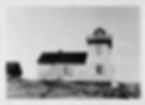Pea Point Island Light, Blacks Harbour, New Brunswick
- Madeline
- Sep 23, 2022
- 4 min read
Updated: Jul 14, 2024

This week we are skipping across North America from Oregon to New Brunswick--Blacks Harbour to be more precise. Blacks Harbor is situated on a small peninsula only about 10 miles from Maine as the crow flies. Driving, you're looking at more like 40 miles. There has been a village at Blacks Harbour for generations, although it was only officially incorporated on November 1, 1972. This year the small community is celebrating 50 years.

Referred to as simply Blacks by the locals, the small fishing village watches day by day as the famous Bay of Fundy tide goes in and out. The village relies almost entirely on fishing sardines. Local families have fished this small herring for generations and will likely continue to do so for many more.

The biggest name in the fishing community at Blacks is Connors Brothers Limited. The family company was founded in 1885 by Lewis and Patrick Connors, and is the largest employer in town aside from the ferry to Grand Manan. In fact, Connors Brothers Limited is the largest sardine company in the world today and employs more than 3,600 people across New Brunswick. Pretty impressive considering its origins in Blacks Harbour, which has only briefly surpassed 1,000 residents. You may be thinking, "but I've never heard of Connors Bros Limited?" No, but you've probably heard of Bumble Bee. The two companies merged in 2004 and were rebranded as Bumble Bee Foods. There have been a number of ownership changes over the years and today the company operates under the name Brunswick in Canada.

The existence of the village is almost entirely due to the growth of Connors Brothers Limited. The company not only owned the land that the community was built on, but the houses, stores, and most of the jobs. In the 19-teens and 20s, Connors Bros paid for early school buildings, the post office, general store, mill, dairy farm, beef farm, hotel, baseball field, and 3 churches. The company brought electricity to the town in 1928 and running water in the 1930s. Later, Connors Bros built the first fire station and hospital. You get the idea.

But tourists don't generally visit sardine factories. Visitors to Blacks are often just passing through for the Grand Manan Island ferry. Many find the Connor Bros Nature Preserve, 106 acres of undisturbed coastline, by accident. Standing tall on this preserve, is Pea Point Island Lighthouse, the reason you are here.

In the 1870s, the Canadian government purchased Pea Island from Mr. Bennet for $75. Later, an additional 5 acres was purchased on the mainland for the future keeper to grow produce and help support himself and his family. The first lighthouse was built at a cost of $1,905 on Pea Island in 1877, nearly 100 years before the village was incorporated. It was first lit in January of 1878, and had a fixed green light amplified using mirrors. This is called a catoptric light. The light was visible for 10 miles and had a small keeper's house attached. The light's characteristic was changed to a continuous white light in 1914 with the installation of a dioptric lens.
Although Blacks Harbour has a small cove, Pea Point Island Light was not built to guide ships into such a small harbor. Pea Point was one of two lights constructed at the entrance to the much larger Letang Harbour, located north of Blacks Harbour. Pea Point marks the eastern side of the calm, deep water harbour and Bliss Island Light marks the west.

This lighthouse lasted for nearly 100 years before it was dismantled and a new beacon was built in the 1960s. The old lighthouse was taken down in pieces in 1965. The new structure, which still stands today, is about 33 feet tall, and consists of a white tower with a red lantern. This time, the tower was constructed of concrete instead of wood to better withstand the elements.

Two keeper's houses were built nearby on the small Pea Island, both of which are now gone. The longest serving lighthouse keeper was Andrew Murray, serving from 1920-1946 (except for 1942, when he served in World War II). The Murrays raised 12 children on the island, and Murray's descendants still live in the area and have numerous photographs of the island in their possession. The last keeper left in the 1980s when the light was automated. One of the keeper's houses burned in 1989 and the other was relocated elsewhere.

Today, the Pea Island Light is definitely beginning to show signs of wear from being perched exposed on a beautiful stretch of rugged shoreline. When visiting, be sure to pay close attention to the tides. You can only access the island at low tide and the Bay of Fundy is known for it's swift, unforgiving tides. I was lucky enough to visit at low tide while waiting for my ferry to Grand Manan. The yellow lichen on the rocks and deep tide pools make for a dramatic yet peaceful landscape.

Keepers:
Alexander Davidson (1877 – 1897)
Warren P. Davidson (1897 – 1898)
Elias C. Dickson (1898 – 1913)
George D. Eldridge (1913 – 1917)
Percival Eldrige (1917 – 1919)
Andrew Wallace (1919 – 1920)
Andrew Murray (1920 – 1946)
Russell Matthews (1942 – 1943)
Edward R. Brown (1946 – 1967)
unknown
Sources:
Village of Blacks Harbour
Brunswick
Heritage Charlotte
Ancestry / Rootsweb